Costa Rica has a diverse and underappreciated cuisine, with a variety of local ingredients and dishes that have been shaped by various cultures over time. From the indigenous communities that grow and process corn to the Afro-Costa Ricans who incorporate coconut milk and root vegetables, the history of food in Costa Rica is a rich tapestry of culinary influences.
The past and present diets of Costa Rica reflect the country’s unique blend of Spanish, African, Indigenous, and American cultures. Each of these influences has left its mark on the cuisine, resulting in a vibrant culinary landscape that is as diverse as the Costa Rican people themselves.
Key Takeaways:
- Costa Rica has a diverse and underappreciated cuisine, with a variety of local ingredients and dishes.
- The past and present diets of Costa Rica have been influenced by Spanish, African, Indigenous, and American cultures.
- Indigenous communities in Costa Rica have a long history of growing and processing corn.
- Afro-Costa Ricans incorporate coconut milk and root vegetables into their dishes.
- Traditional dishes in Costa Rica include gallo pinto, chifrijo, and casado.
The Influence of Cultures on Costa Rican Cuisine
The past and present diets of Costa Rica have been shaped by a mix of cultures, including Spanish, African, Indigenous, and American. These influences have greatly contributed to the diverse and underappreciated cuisine in the country. Indigenous communities in Costa Rica have a rich history of growing and processing corn, which remains a staple in many traditional dishes. On the other hand, Afro-Costa Ricans have introduced ingredients such as coconut milk and root vegetables, adding their unique flavours to the cuisine.

The Spanish influence on Costa Rican cuisine is undeniable. With the arrival of the Spanish colonizers, new ingredients like rice, wheat, and various spices were introduced. These ingredients became integral in dishes such as gallo pinto, a popular Costa Rican breakfast dish made with rice and beans. The African influence can be seen in dishes like chifrijo, which combines fried pork with red beans, inspired by the African tradition of using beans in their cooking.
The Indigenous and African influences are not the only cultural contributions to Costa Rican cuisine. The American influence, particularly from the United States, has also made its mark. The introduction of new cooking techniques and ingredients has led to the creation of fusion dishes that combine different culinary styles. This blending of cultures has resulted in a culinary landscape that is constantly evolving, with new flavours and combinations emerging.
Overall, the diverse cultural influences on Costa Rican cuisine have created a rich and vibrant food culture. The fusion of Spanish, African, Indigenous, and American flavours has shaped the past and present diets in the country, making Costa Rican traditional foods truly unique and worth exploring.
Traditional Dishes of Costa Rica
Costa Rica is known for its traditional dishes that have become a part of the country’s culinary identity, including gallo pinto, chifrijo, and casado. Gallo pinto, which means “spotted rooster,” is a beloved breakfast dish consisting of rice and black beans cooked together and seasoned with onions, bell peppers, and spices. It is often served with eggs, fried plantains, and sour cream, making it a satisfying and hearty meal to start the day.
The chifrijo, on the other hand, is a popular dish enjoyed throughout the day, especially during social gatherings and sporting events. It is a delightful combination of crispy pork pieces, red beans, rice, and pico de gallo, topped with a layer of avocado and served with tortilla chips. The contrasting flavours and textures of this dish make it a true crowd-pleaser.
Another staple in Costa Rican cuisine is casado, which translates to “married man.” This dish is so named because it typically consists of a marriage of various elements on one plate: rice, black beans, salad, fried plantains, and a choice of protein such as grilled chicken, fish, or beef. Casado perfectly embodies the concept of a balanced meal, as it offers a variety of flavours and nutrients in one satisfying dish.
| Traditional Dish | Description | Key Ingredients |
|---|---|---|
| Gallo Pinto | A popular breakfast dish consisting of seasoned rice and black beans | Rice, black beans, onions, bell peppers, spices |
| Chifrijo | A flavorful combination of crispy pork, red beans, rice, and pico de gallo | Pork, red beans, rice, pico de gallo, avocado |
| Casado | A balanced meal with rice, black beans, salad, fried plantains, and a choice of protein | Rice, black beans, salad, fried plantains, protein (chicken, fish, or beef) |

“Costa Rican cuisine is a rich tapestry of flavors, and these traditional dishes are just a taste of what the country has to offer. From the comforting and savory gallo pinto to the vibrant and zesty chifrijo, each bite tells a story of the diverse cultural influences that shape Costa Rican food. Whether you’re a fan of rice and beans or in search of a satisfying combo plate, the traditional dishes of Costa Rica are sure to tantalize your taste buds.”
Enjoy the flavours of Costa Rica
When exploring Costa Rica, be sure to savour the local cuisine and experience the vibrant flavours that have made these traditional dishes so beloved. Whether you’re dining at a local soda (small eatery) or trying your hand at cooking in a local cooking class, the traditional dishes of Costa Rica offer a true taste of the country’s culinary heritage. With their combination of fresh ingredients, bold flavours, and cultural influences, these dishes are a delicious reflection of Costa Rica’s diverse and underappreciated culinary scene.
- Experience the rich flavours of gallo pinto for a traditional Costa Rican breakfast.
- Indulge in the hearty and satisfying chifrijo for a taste of the country’s popular pub fare.
- Savour the balanced and diverse flavours of casado, the national dish of Costa Rica.
As you embark on your culinary journey through Costa Rica, be prepared to discover a world of unique flavours and culinary traditions that celebrate the country’s rich cultural heritage. From the traditional staples to the regional specialities, Costa Rican cuisine is sure to leave a lasting impression on your taste buds.
Street Food of Costa Rica – Video Tour
Abundant Fruits and Vegetables of Costa Rica
Costa Rica’s cuisine is characterized by its abundant use of fresh fruits and vegetables, which are integral to dishes like picadillos and ceviche. The country’s fertile land and tropical climate provide an ideal environment for cultivating a wide variety of produce. From vibrant tropical fruits like mangoes, pineapples, and papayas to an array of vegetables such as tomatoes, peppers, and yuca, Costa Rica offers a bounty of flavours and textures.
“Our commitment to using fresh, locally sourced ingredients is what sets Costa Rican cuisine apart,” says Chef Maria Sanchez, a renowned expert in Costa Rican gastronomy. “We believe that the quality and freshness of our ingredients are what truly elevate our dishes and make them truly special.”
To showcase the abundance of fruits and vegetables, picadillos are a staple in Costa Rican kitchens. These colourful vegetable hashes are made by sautéing a combination of finely chopped vegetables like squash, chayote, and bell peppers. The mix of flavours is enhanced with spices and herbs, creating a vibrant and nutritious side dish that pairs well with any meal.
“Costa Rican ceviche is a refreshing and light dish that highlights the natural flavors of the abundant seafood and fresh produce available in the country,” explains Chef Sanchez. “The combination of marinated fish or shrimp with citrus juices, onions, and cilantro creates a zesty and tangy blend, perfect for a sunny day at the beach.”
So next time you visit Costa Rica, be sure to indulge in the country’s flavorful picadillos and refreshing ceviche, made with the finest local fruits and vegetables. The colorful and nutrient-rich dishes will not only satisfy your taste buds but also provide a true taste of Costa Rican gastronomy.

Note: The image above showcases the vibrant fruits and vegetables commonly used in Costa Rican cuisine, highlighting the country’s dedication to fresh and local ingredients.
| Fruits | Vegetables |
|---|---|
| Mango | Squash |
| Pineapple | Chayote |
| Papaya | Bell peppers |
| Watermelon | Tomatoes |
| Guava | Yuca |
Local Drinks and Sauces
A taste of Costa Rican cuisine is incomplete without trying the local drinks and sauces that add a unique touch to the flavours. Costa Rica’s vibrant food scene is complemented by a variety of refreshing beverages and flavorful condiments. Whether you’re enjoying a typical meal or exploring the culinary delights of the country, be sure to indulge in these delightful additions to truly experience the essence of Costa Rican cuisine.
When it comes to local drinks, frescos are at the top of the list. These fruity concoctions are made by blending fresh tropical fruits like mango, pineapple, and watermelon with ice and a touch of sugar. The result is a refreshing and thirst-quenching beverage that perfectly complements the tropical climate of Costa Rica. Sip on a glass of refreshing fresco while enjoying a meal or exploring the beautiful landscapes of this Central American paradise.
Salsa Lizano is a traditional sauce that holds a special place in Costa Rican cuisine. This versatile condiment is made from a blend of vegetables, spices, and vinegar, creating a unique flavour profile that enhances the taste of various dishes. It is a staple on the tables of Costa Rican households and can be found in countless restaurants across the country. Salsa Lizano is often drizzled over rice, beans, meats, and even breakfast dishes like gallo pinto to add a burst of flavour.

While frescos and Salsa Lizano are the highlights, Costa Rican cuisine offers a plethora of other delightful local drinks and sauces to explore. From horchata, a rice-based drink flavoured with cinnamon and vanilla, to Lizano-style hot sauce, which adds a spicy kick to any dish, there is something for every palate. These local drinks and sauces not only complement the flavours of Costa Rican cuisine but also showcase the country’s rich culinary heritage and the creativity of its people.
So, the next time you find yourself in Costa Rica, make sure to savour the local drinks and sauces alongside the traditional dishes. Immerse yourself in the vibrant flavours and discover the true essence of Costa Rican cuisine through these delightful additions.
Regional Specialties in Costa Rica
Costa Rican cuisine showcases a rich diversity of regional specialities, with each province offering its own unique dishes and food traditions. From the coastal regions to the mountainous areas, the country’s culinary landscape is a delightful tapestry of flavours and ingredients.
In Guanacaste, you’ll find specialities like arroz de maíz (corn rice) and tortillas made from white corn, which is a staple in the local diet. The Caribbean province of Limón is known for its Afro-Caribbean influence, with dishes like patí (meat-filled pastry) and rondón (seafood stew) reflecting the vibrant flavours of the region.
Heading inland to the Central Valley, the province of Cartago is famous for its olla de carne, a hearty meat and vegetable stew that warms the soul. The bustling capital city of San José is a melting pot of culinary delights, featuring street food favourites like chorreadas (corn pancakes) and churros. In the coastal province of Puntarenas, seafood takes centre stage, with ceviche and whole-fried fish being popular choices.
No matter where you go in Costa Rica, you’re sure to encounter festive foods that are deeply rooted in the country’s cultural heritage. From the vibrant colours of a plate of picadillo to the bold flavours of a freshly grilled churrasco, each regional speciality tells a story of the diverse influences that have shaped Costa Rican cuisine over the centuries.
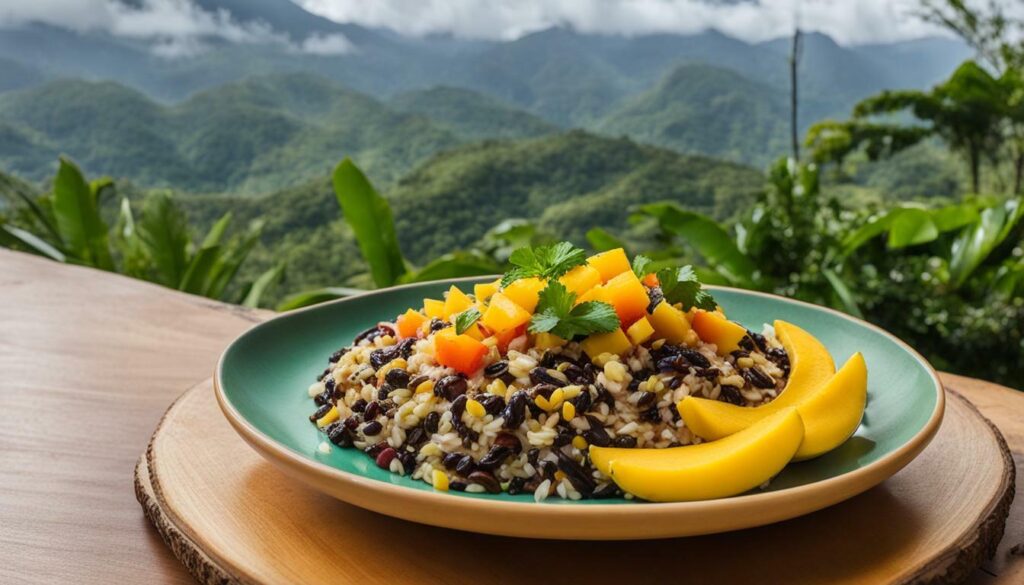
| Province | Specialties |
|---|---|
| Guanacaste | Arroz de maíz, tortillas made from white corn |
| Limón | Patí, rondón |
| Cartago | Olla de carne |
| San José | Chorreadas, churros |
| Puntarenas | Ceviche, whole fried fish |
Costa Rican Food: Flavorful and Nutritious
Costa Rican food is celebrated for its delicious flavours and nutritional value, with a focus on using fresh ingredients to create well-balanced meals. The country’s diverse cuisine incorporates a wide variety of local ingredients, resulting in vibrant and satisfying dishes that reflect the rich culinary history of Costa Rica.
Fresh ingredients play a central role in Costa Rican cooking, with an abundance of fruits, vegetables, and locally sourced produce. The cuisine heavily relies on the natural flavours of these ingredients, highlighting their freshness and quality. From tropical fruits like mangoes and pineapples to leafy greens and root vegetables, the array of fresh produce adds both taste and nutritional value to Costa Rican dishes.
In addition to the emphasis on fresh ingredients, Costa Rican cuisine is known for its balanced meals. Traditional dishes often consist of a combination of proteins, carbohydrates, and vegetables, providing a well-rounded and nourishing dining experience. One popular example is the casado, a combo plate typically featuring rice, black beans, meat or fish, and salad. This combination ensures a satisfying and complete meal, offering a mix of flavours and essential nutrients.
Overall, Costa Rican food dishes capture the essence of the country’s bountiful natural resources and cultural heritage. With its delightful flavours, nutritious ingredients, and commitment to balanced meals, Costa Rican cuisine continues to captivate both locals and visitors alike.
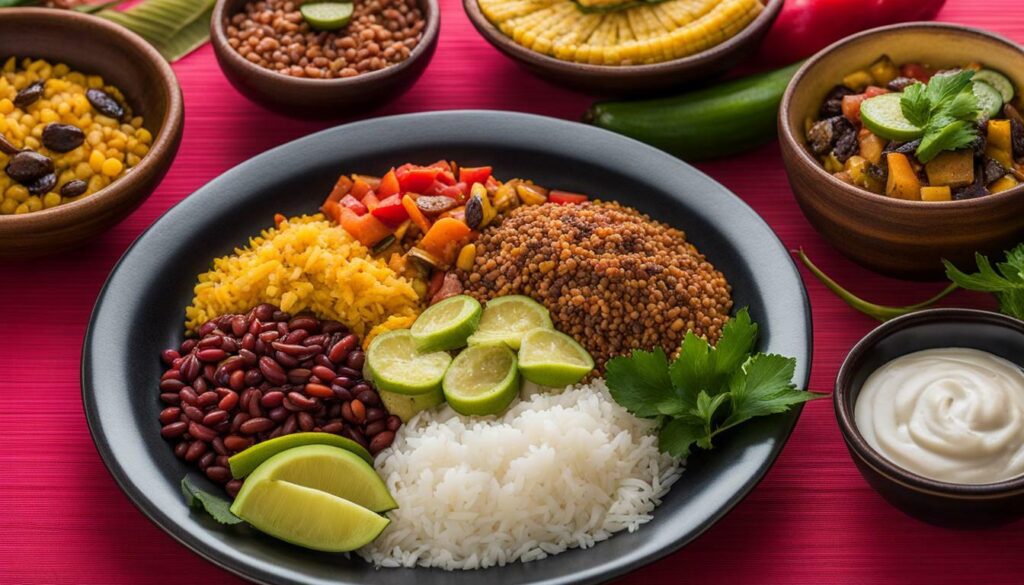
| Costa Rican Food Dishes | Flavorful and Nutritious |
|---|---|
| Gallo Pinto | A traditional dish consisting of rice, black beans, and spices. It is a staple breakfast option in Costa Rica and is packed with protein and fiber. |
| Ceviche | A refreshing dish made with fresh fish or seafood marinated in citrus juices, herbs, and vegetables. It is a light and zesty option rich in vitamins and omega-3 fatty acids. |
| Arroz con Pollo | A classic Costa Rican dish that combines rice, chicken, and vegetables. It is a hearty and satisfying meal providing a balance of protein, carbohydrates, and essential vitamins. |
| Plantains | A versatile ingredient used in numerous Costa Rican dishes. Plantains are rich in vitamins A and C and provide a healthy source of carbohydrates. |
Testimonial:
“The flavors of Costa Rican cuisine are simply amazing. Each bite is bursting with freshness and unique combinations of ingredients. It’s a culinary experience like no other!” – Maria, Food Enthusiast
The Evolution of Costa Rican Cuisine
Costa Rican cuisine has undergone an evolution, blending traditional recipes with modern influences to create innovative fusion dishes. The rich cultural heritage of the country has shaped its culinary traditions, and over time, new flavours and techniques have been introduced, adding a contemporary twist to traditional dishes. This evolution reflects the vibrant and diverse nature of Costa Rican food, making it a unique and exciting culinary experience.
One of the main influences on the evolution of Costa Rican cuisine is the fusion of different culinary styles. As the country became more accessible to international influences, chefs began to experiment with new ingredients and cooking methods. This led to the creation of exciting fusion dishes that combine elements from various cultures. For example, Costa Rican sushi combines the flavours of Japanese sushi with local ingredients like plantains and mango, resulting in a delicious and unexpected combination of flavours.
In addition to fusion dishes, modern influences have also shaped the evolution of Costa Rican cuisine. Global food trends and innovations have found their way into the country’s food scene, inspiring chefs to create new and innovative recipes. From gourmet food trucks that serve gourmet versions of traditional street food to upscale restaurants offering creative interpretations of classic dishes, Costa Rican cuisine has embraced the modern culinary movement.
| Dish | Traditional Ingredients | Modern Twist |
|---|---|---|
| Gallo Pinto | Rice, black beans, onions, peppers | Added avocado, fried plantains |
| Ceviche | Fresh fish, lime juice, onions, cilantro | Added mango, coconut milk |
| Casado | Rice, beans, meat, salad, plantains | Added quinoa, roasted vegetables |
The evolution of Costa Rican cuisine is a testament to the dynamic nature of food and the creativity of its chefs. It continues to evolve as new culinary trends emerge and as chefs explore new flavours and techniques. This results in a culinary landscape that is constantly changing and evolving, offering locals and visitors alike an exciting and diverse dining experience in Costa Rica.
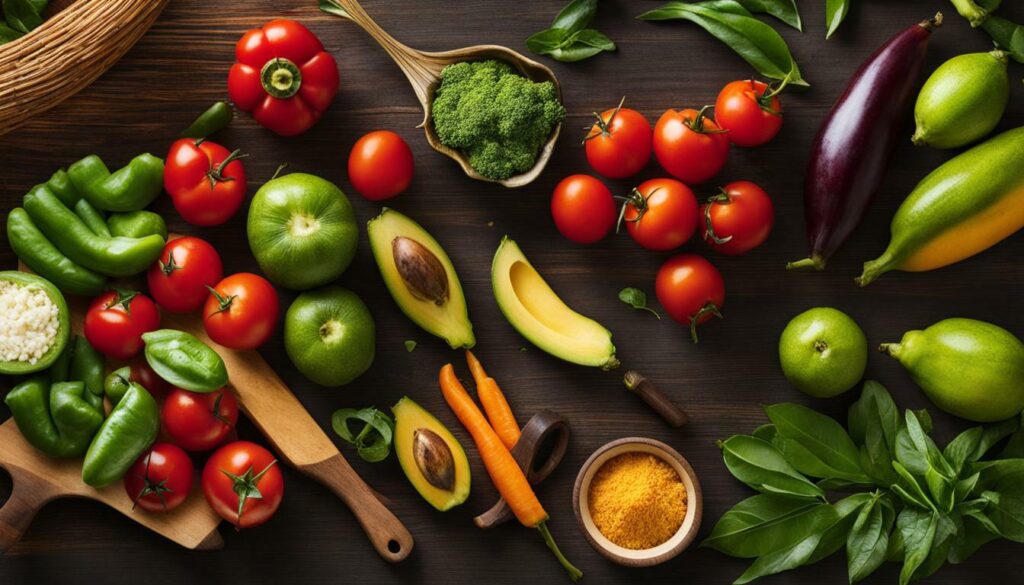
Culinary Tourism in Costa Rica
Culinary tourism is on the rise in Costa Rica, offering visitors a chance to experience the country’s vibrant food culture through local markets and immersive cooking classes. With its diverse and underappreciated cuisine, Costa Rica provides a unique culinary experience for food enthusiasts.
One of the best ways to explore the local food scene is by visiting the bustling local markets. These markets are filled with a wide variety of fresh produce, spices, and traditional ingredients. Wander through the colourful stalls and interact with local vendors to learn about the different fruits, vegetables, and spices used in Costa Rican cooking. It’s an opportunity to discover new flavours and ingredients that you might not find elsewhere.
“The markets of Costa Rica are a feast for the senses. The vibrant colors, enticing aromas, and friendly vendors make it a truly immersive experience,” says Maria Rodriguez, a culinary enthusiast and frequent visitor to Costa Rica.
Immersive cooking classes
To truly immerse yourself in the Costa Rican culinary culture, consider taking a cooking class. These classes are led by local chefs who will guide you through the preparation of traditional Costa Rican dishes. You’ll learn about the various techniques, ingredients, and flavours that make up the country’s cuisine. From making hand-pressed tortillas to preparing ceviche, these classes offer a hands-on experience that allows you to delve deeper into the local food traditions.
Whether you’re a seasoned chef or a novice in the kitchen, these cooking classes cater to all skill levels. You’ll have the opportunity to ask questions, interact with the chef and fellow participants, and of course, enjoy the delicious dishes you’ve prepared.
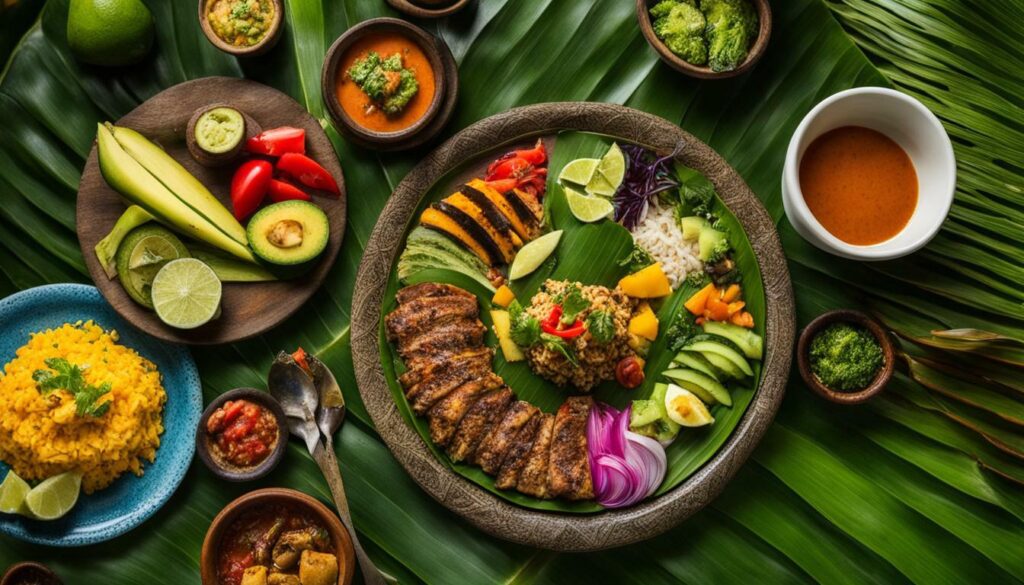
Discover the vibrant food culture
By engaging in culinary tourism in Costa Rica, you’ll not only satisfy your taste buds but also gain a deeper understanding of the country’s rich cultural heritage. Through the exploration of local markets and participation in cooking classes, you’ll discover the unique flavours, ingredients, and cooking techniques that have shaped Costa Rican cuisine over the years.
So, if you’re a food lover looking for a unique travel experience, consider embarking on a culinary journey through Costa Rica. From the bustling markets to the hands-on cooking classes, there’s no better way to immerse yourself in the vibrant food culture of this beautiful country.
| Culinary Experiences | Benefits |
|---|---|
| Visiting local markets | Discover a wide variety of fresh produce and traditional ingredients |
| Participating in cooking classes | Learn about local cooking techniques and flavors |
| Exploring regional specialties | Experience the diverse food culture across different provinces |
| Sampling traditional dishes | Indulge in the flavours of gallo pinto, chifrijo, and other Costa Rican classics |
Sustainable and Farm-to-Table Practices
Costa Rica’s commitment to sustainable practices is reflected in its farm-to-table approach, prioritizing locally sourced, organic ingredients. The country’s rich biodiversity and fertile lands provide an ideal environment for sustainable farming and fishing practices, ensuring that the food consumed is not only delicious but also environmentally friendly.
One of the key aspects of sustainable practices in Costa Rica is the emphasis on organic farming. Farmers prioritize the use of natural fertilizers and pest control methods, avoiding the use of harmful chemicals that can damage the ecosystem. This approach not only ensures the production of high-quality, chemical-free produce but also contributes to the overall health of the soil and surrounding environment.
Another important aspect of Costa Rica’s sustainable practices is the focus on supporting local farmers and businesses. The farm-to-table concept promotes the idea of buying directly from local producers, reducing the carbon footprint associated with long-distance transportation and supporting the local economy. By sourcing ingredients locally, restaurants and food establishments also have better control over the quality and freshness of the ingredients they use, resulting in a more flavorful culinary experience for consumers.
The Benefits of Sustainable Practices
Implementing sustainable and farm-to-table practices in Costa Rican cuisine brings several benefits. Firstly, it helps preserve the country’s natural resources by promoting responsible farming methods and reducing waste. Additionally, by supporting local farmers, the practice contributes to the growth of the agricultural sector, ensuring the long-term sustainability of the food industry.
Furthermore, sustainable practices in Costa Rica contribute to the overall health and well-being of consumers. By prioritizing organic farming, the use of harmful chemicals is minimized, resulting in healthier and more nutritious produce. This, in turn, translates into healthier meals for individuals, making Costa Rican cuisine an excellent choice for those seeking both delicious and nutritious food options.
| Benefits of Sustainable Practices in Costa Rican Cuisine |
|---|
| Preserves natural resources |
| Supports local farmers and businesses |
| Reduces carbon footprint |
| Promotes healthier and more nutritious meals |
Costa Rica’s dedication to sustainable practices and its farm-to-table approach is not only a testament to its commitment to environmental conservation but also a reflection of the country’s deep appreciation for quality, fresh ingredients. By embracing organic farming and supporting local producers, Costa Rican cuisine continues to thrive in a way that is both delicious and sustainable, offering a unique culinary experience for locals and visitors alike.
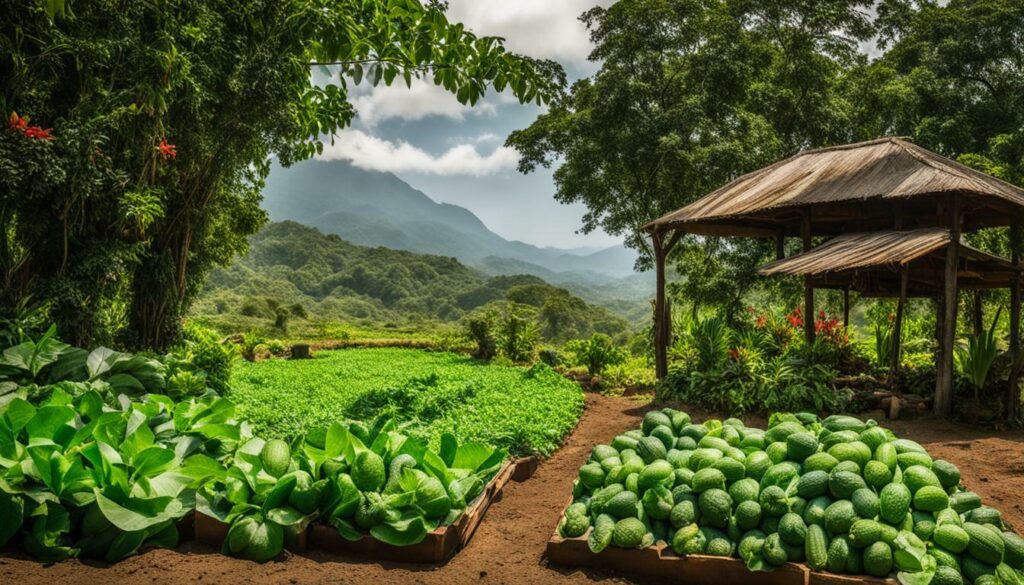
Conclusion
In conclusion, exploring the past and present diets of Costa Rica reveals a diverse and underappreciated culinary landscape, influenced by a mix of cultures and celebrated for its flavorful and nutritious dishes.
The country’s culinary heritage is a fusion of indigenous, Spanish, African, and American influences, resulting in a rich and vibrant food culture. Indigenous communities play a vital role in growing and processing corn, while Afro-Costa Ricans incorporate coconut milk and root vegetables into their traditional dishes.
Costa Rican cuisine is known for its traditional dishes such as gallo pinto (rice and beans), chifrijo (fried pork with red beans), and casado (a combination plate). These dishes exemplify the use of fresh ingredients and the balanced flavours that define Costa Rican food. Abundant fruits and vegetables are also prevalent in Costa Rican cooking, with picadillos (vegetable hash) and ceviche being popular dishes that showcase the diversity of local produce.
When exploring the regional specialities of Costa Rica, one can discover a wide range of festive foods, popular dishes, and famous foods unique to each province. From coastal regions known for their fresh seafood to mountainous areas offering hearty stews and grilled meats, the regional variations in Costa Rican cuisine provide a fascinating culinary journey.
FAQ
What is the history of food in Costa Rica?
Costa Rica has a diverse and underappreciated cuisine, influenced by a mix of cultures including Spanish, African, Indigenous, and American. Indigenous communities grow and process corn, while Afro-Costa Ricans use coconut milk and root vegetables.
What are some traditional dishes in Costa Rica?
Traditional dishes in Costa Rica include gallo pinto (rice and beans), chifrijo (fried pork with red beans), and casado (combo plate).
What fruits and vegetables are abundant in Costa Rica?
Costa Rica is known for its abundant fruits and vegetables, which are used in dishes such as picadillos (vegetable hash) and ceviche.
What are some local drinks and sauces in Costa Rica?
Local drinks in Costa Rica include frescos (fruit drinks), and traditional sauces like Salsa Lizano are popular.
Are there regional specialities in Costa Rica?
Yes, different regions of Costa Rica have their own specialities and unique food traditions.
Is Costa Rican food flavorful and nutritious?
Yes, Costa Rican food is known for its flavorful and nutritious nature, with an emphasis on fresh ingredients and balanced meals.
How has Costa Rican cuisine evolved over time?
Costa Rican cuisine has evolved with modern influences and the emergence of fusion dishes that combine different culinary styles.
Is there a trend of culinary tourism in Costa Rica?
Yes, there is a growing trend of culinary tourism in Costa Rica, where visitors can explore the local food scene, visit vibrant markets, and participate in cooking classes.
Are there sustainable and farm-to-table practices in Costa Rican cuisine?
Yes, there is an emphasis on sustainable practices and farm-to-table principles in Costa Rican cuisine, with a focus on using locally sourced, organic ingredients.
What is the conclusion about Costa Rican cuisine?
Costa Rican cuisine is diverse and underappreciated, with a rich history influenced by various cultures. It offers flavorful and nutritious dishes, with an emphasis on fresh ingredients and balanced meals.
Source Links
- https://villafirenzecr.com/everything-you-need-to-know-about-costa-rican-diet/
- https://www.eater.com/21516828/costa-rican-food-explainer-dishes-drinks
- https://casateresacr.com/exploring-costa-ricas-food-culture-with-casa-teresa-luxury-villa/



